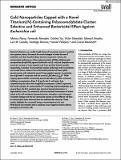Por favor, use este identificador para citar o enlazar a este item:
http://hdl.handle.net/10261/343736COMPARTIR / EXPORTAR:
 SHARE SHARE
 CORE
BASE CORE
BASE
|
|
| Visualizar otros formatos: MARC | Dublin Core | RDF | ORE | MODS | METS | DIDL | DATACITE | |

| Título: | Gold nanoparticles capped with a novel titanium(IV)-containing polyoxomolybdate cluster: Selective and enhanced bactericidal effect against Escherichia coli |
Autor: | Paesa, Mónica CSIC ORCID; Almazán, Fernando CSIC ORCID ; Yus, Cristina CSIC ORCID; Sebastián, Víctor CSIC ORCID; Arruebo, Manuel CSIC ORCID; Gandía, Luis M.; Reinoso, Santiago; Pellejero, Ismael; Mendoza, Gracia | Fecha de publicación: | 2023 | Editor: | Wiley-VCH | Citación: | Small: 2305169 (2023) | Resumen: | Bacterial infections are a public health threat of increasing concern in medical care systems; hence, the search for novel strategies to lower the use of antibiotics and their harmful effects becomes imperative. Herein, the antimicrobial performance of four polyoxometalate (POM)-stabilized gold nanoparticles (Au@POM) against Escherichia coli (E. coli) and Staphylococcus aureus (S. aureus) as Gram-negative and Gram-positive bacteria models, respectively, is studied. The bactericidal studies performed, both in planktonic and sessile forms, evidence the antimicrobial potential of these hybrid nanostructures with selectivity toward Gram-negative species. In particular, the Au@GeMoTi composite with the novel [Ti2 (HGeMo7 O28 )2 ]10- POM capping ligand exhibits outstanding bactericidal efficiency with a minimum inhibitory concentration of just 3.12 µm for the E. coli strain, thus outperforming the other three Au@POM counterparts. GeMoTi represents the fourth example of a water-soluble TiIV -containing polyoxomolybdate, and among them, the first sandwich-type structure having heteroatoms in high-oxidation state. The evaluation of the bactericidal mechanisms of action points to the cell membrane hyperpolarization, disruption, and subsequent nucleotide leakage and the low cytotoxicity exerted on five different cell lines at antimicrobial doses demonstrates the antibiotic-like character. These studies highlight the successful design and development of a new POM-based nanomaterial able to eradicate Gram-negative bacteria without damaging mammalian cells. | Versión del editor: | https://doi.org/10.1002/smll.202305169 | URI: | http://hdl.handle.net/10261/343736 | DOI: | 10.1002/smll.202305169 | E-ISSN: | 1613-6829 |
| Aparece en las colecciones: | (INMA) Artículos |
Ficheros en este ítem:
| Fichero | Descripción | Tamaño | Formato | |
|---|---|---|---|---|
| goldcoli.pdf | 3,02 MB | Adobe PDF |  Visualizar/Abrir |
CORE Recommender
SCOPUSTM
Citations
2
checked on 14-may-2024
Page view(s)
20
checked on 13-may-2024
Download(s)
3
checked on 13-may-2024
Google ScholarTM
Check
Altmetric
Altmetric
Este item está licenciado bajo una Licencia Creative Commons

